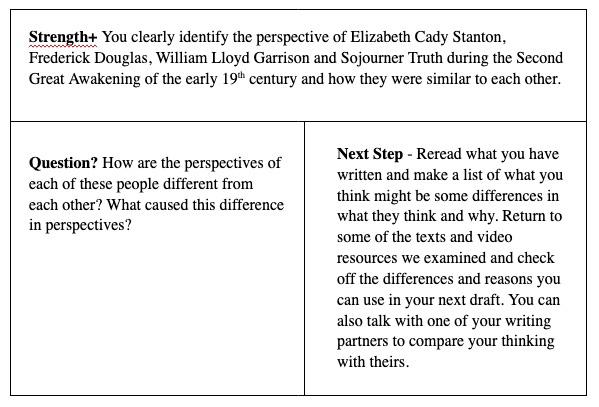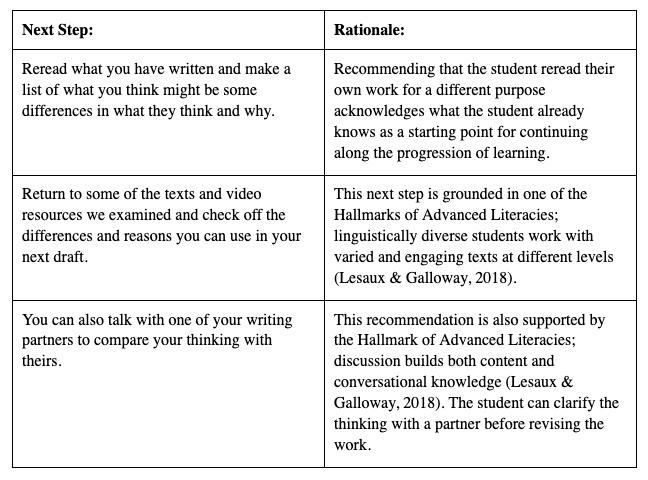
8 minute read
Building Equitable Learning Experiences
Building Equitable Learning Experiences through the Formative Assessment and Feedback Process
Angela Di Michele Lalor
Angela Di Michele Lalor is a national educational consultant who has facilitated schoolwide professional development initiatives for over 20 years. She is the author of Making Curriculum Matter: How to Build SEL, Equity and Other Valued Priorities into Daily Instruction and Ensuring High Quality Curriculum: How to Design, Revise or Adopt Curriculum Aligned to Student Success. You can learn more about Angela here.
Have you ever passed the same construction site and noticed its progress? For months, I ran past an empty lot and then, one day, it was busy with activity. Week by week, I watched as a structure slowly took shape. I noticed the variety of trucks parked in the driveway as different workers completed their specific tasks. While their work seemed separate, together, they created a house. Eventually, plantings appeared, then paving stones and other signage, reflecting the family that now lives there. As a homeowner myself, I know that workers will return to make changes and repairs to strengthen the structure and address the owner’s new needs as they arise. When they do, the contractors may use new materials and techniques or use existing ones in new ways.
It is all part of the building process. A process educators need to keep in mind as they work towards building equity for their students. Equity is addressing individualized attributes of students so they can engage in learning and eliminating those practices that prevent them from reaching their full potential (Lalor, 2021). Accomplishing this requires a multidimensional approach. On the construction site, workers with different areas of expertise came together to create a structure to serve the owner and the intended use of the building. In a school that attends to equity, educators, parents, community and board members come together to ensure that
students learn in a welcoming and affirming environment, where they have access to high expectations and rigorous instruction, and an inclusive curriculum and assessment system (NYSED, 2017). • learning strategies that consider the individuality of each student.
In this article, I explain how schools can leverage the formative assessment process
In my work helping schools design inclusive curriculum and assessment systems, I found that formative assessment is an essential and powerful assessment practice that attends to equity. A formative assessment is a product or demonstration of learning that can be used to check for student understanding (Fisher & Frey, 2007). The formative assessment process is one where the information is used by the teacher to provide students with feedback and adjust instruction. The process also ensures students are involved and invested in understanding where they are in their learning and what steps they need to take to reach their goals. When teachers and students engage in the formative assessment process, they address principles of equity in schools by providing:
• a structure that teachers can use so all students can access high expectations;
• students with opportunities to become self-regulated, independent learners; as one means of building equitable learning experiences for students.
All students have access to highexpectations.
Effective formative assessment is built on the collective belief that students of all races, ethnicities, socioeconomic classes, genders, abilities, and languages can and will learn. For this to occur, teachers must take the necessary step of examining their own identities and experiences to be aware of how they impact their beliefs about their students. While engaging in this process, teachers may begin to recognize when they lower or modify expectations for students because of assumptions or biases. They can then work toward changing practices that prevent students from reaching their full potential. When teachers use the formative assessment process, they see what students can do and the talents they bring to the classroom, and as a result, shift their thinking.
The first step of the formative assessment process is ensuring there is a clearly identified learning target for the day and students understand what it means and how to use it. It’s essential that this learning target be about learning, not the activity students are doing. As an example, a learning target such as, I can analyze multiple accounts of the same event, focuses on the skill students will learn but a target such as, I can complete a graphic organizer, focuses on the activity students will do. The teacher may have designed the organizer to identify key elements for analyzing accounts of the same event, but student attention has been drawn away from this important information to focus on completing the organizer. The graphic organizer serves as the formative assessment opportunity that can be used for engaging in the formative assessment process. When a target focuses on the learning and contains success criteria, students can more fully engage in the formative assessment process. Here is the same learning target with success criteria:
I can analyze multiple accounts of the same event by:
• identifying the perspective of each individual
• determining important similarities and differences
The learning target with success criteria provide students with a cognitive tool that they can transfer to new texts or activities when they need to analyze multiple accounts of the same event. Students are the owners of their learning, rather than relying on the teacher to identify and share the tool they need to learn.
Feedback supports self-regulated, independent learners.
For students to grow as learners, they need to answer the questions: what do I need to learn, how well have I learned it and what do I need to do next? (Frey, Hattie & Fisher, 2016). Feedback that includes strengths, questions/needs, and next steps, that are based on clear learning targets and success criteria, help students answer these questions.
The chart on the following page illustrates feedback that a teacher provided to a student based on the previously shared learning target and success criteria. In this example, the teacher’s feedback describes the student’s strengths and needs. It then offers specific actions the student can take to address those needs. These three components are essential to the formative assessment process because they support students as they work towards high expectations and help students develop selfregulation strategies.
Strength-Based Feedback Chart, Lalor 2022

Students should be part of the feedback process through peer feedback and selfassessment. Students are best equipped to participate in peer feedback when they are provided with a learning target that includes success criteria and a protocol or structure for giving feedback. “Strengths, questions, next steps” shared in this piece, “glows and grows”, and “two stars and a wish” are all simple ways students of all ages can engage in the process. As students provide feedback to their peers, they are better able to recognize strengths, needs, and next steps in their own work when they engage in self-assessment. Opportunities for self-assessment help students to become independent, self-regulated learners able to set and achieve high expectations.
Learning strategies consider the individuality of each student.
Describing student strengths validates and affirms the learner. It reinforces the skills or strategies students use so they are more likely to duplicate them in future learning experiences. Even in those cases where students have not fully demonstrated the learning target, strengths are written
in terms of what students can do so they can be leveraged to progress along the continuum of learning. In this way, the student and teacher recognize individual strengths which communicate students can meet high expectations.
Needs, which can also be written as questions, identify where students should focus their attention in the next phase of learning. They are accompanied by specific, actionable next steps so students can address these areas as they continue to work toward the learning target. Identifying next steps fosters the development of self-regulation and independence. background. They incorporate best practices that support English Language Learners.
The formative assessment process is only one of the many ways to create an inclusive curriculum and assessment that builds equitable learning experiences. When appropriately leveraged, formative assessments can be used so all students have access to high expectations in a way that honors students’ individuality and allows students to become independent, self-regulated learners, all key principles to building equity.
In providing feedback, next steps must be cognizant of student individuality. Teachers need to consider what strategies would be most beneficial to the student based on the student’s learning needs but also leveraging students’ assets, interests, and learning preferences. In the feedback above, the teacher provides next steps that
REFERENCES
Fisher, D. & Frey, N. (2007) Check for
Understanding. Alexandria, VA: ASCD.
• makes connections to what the student already knows
• uses layered texts
• suggests talking before writing
These next steps are particular to this student and, as explained in the chart on the following page, based on the student’s linguistic Frey, N., Hattie, J. & Fisher, D. (2016). Developing
Assessment-Capable Visible Learners, Grades
K – 12: Maximizing Skill, Will, and Thrill.
Newbury Park, CA: Corwin.
Lalor, A. (2021). Making curriculum matter: How to build SEL, equity and other priorities into daily instruction.
Alexandria, VA: ASCD.
Feedback with Next Steps Chart, Lalor 2022

Lesaux, N. & Galloway, E. (2018). “Hallmark 1 of Advanced Literacies Instruction:
Engaging, Content-Rich Texts.”
Linguistically Diverse Learners and the
NYS Next Generation P – 12 Learning
Standards. Brief 3 0f 8. NYSED
Lesaux, N. & Galloway, E. (2018). “Hallmark of Advanced Literacies Instruction:
Classroom Instruction.” Linguistically
Diverse Learners and the NYS Next
Generation P – 12 Learning Standards.
Brief 4 of 8. NYSED NYSED. (2018). Culturally Responsive-
Sustaining Education Framework.
Retrieved from Framework | New York
State Education Department (nysed.gov)





